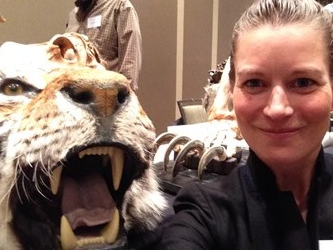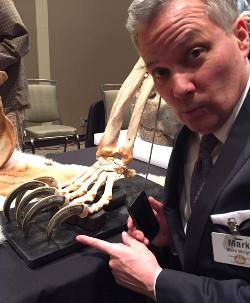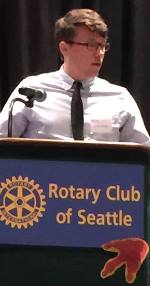Review of March 23, 2016
Stories from The Burke, Old and New
.gif)
Reporter: Gary Smith
The takeaway from this week’s program might be that if you want to hear a good story, find yourself a good historian. Or better yet, a good museum.
The takeaway from this week’s program might be that if you want to hear a good story, find yourself a good historian. Or better yet, a good museum.
Washington’s first museum, officially the Washington State Museum of Natural History and Culture but what everyone knows as “The Burke,” cares for 16 million biological, geological and cultural objects. Since these tell the story of the earth and its creatures, you might say that Dr. Julie Stein, the Burke’s Executive Director, has a million stories. She shared a few, and captivated the Rotarians.


Stein explained that the common name of the museum occurred because early Seattle Judge Thomas Burke and his wife, Caroline McGilvra Burke, were early collectors of Northwest Native art and bequeathed their estate to the Museum. Judge Burke, Stein reported, was also a cofounder of Seattle Rotary #4.
Looking for new answers in old things
The Burke is a place for exploration, Stein said. The museum’s samples are being used today for research unimaginable when much of the collection was assembled. “In biology today, all questions are really about DNA, and isotopes,” Stein said. “One day the Burke got a request from a biotech startup in Australia. They were interested in studying the genes that control the human immune system, especially the genes involved in Influenza A virus, which can cause death. They wanted to study and compare the evolutionary sequence of the DNA in 13 specific carnivores to learn which became immune to that virus and which did not. Of all the institutions in the world, only the Burke possessed every one.”

You never know what you might find
Dr. Stein also related a story of modern discovery – of a mammoth tusk uncovered by construction in South Lake Union in 2014. After about 20,000 years in Seattle, it was, understandably, soggy and limp. In fact, if it had been moved without expert help, it would have disintegrated.
Working at night to not disrupt construction activity, Burke scientists carefully unearthed the full tusk and eventually transported it to the museum, where they started a very slow process of drying and preserving the tusk. During removal, one of the 8,000 curious and thrilled Seattleites who came to watch gushed to Stein, “I never knew a mammoth lived under my apartment building!” Proving, I suppose, that while you never know what might have lived under your apartment building – the Burke might.
 Instilling valuable skills
Instilling valuable skillsTurning to the Burke’s cultural treasures, Stein told how the Burke helped turn a great young athlete with little interest in school into a First-team Academic All-American – the University of Washington’s first in 23 years. Danny Shelton, a Pacific Islander who grew up in Auburn, embraced learning how his culture conveys knowledge outside of books. He dove deep into research that he now shares with others, both here and in Polynesia. Shelton earned a 3.54 GPA in anthropology and is now a starting defensive lineman for the Cleveland Browns, but he maintains his engagement with the Burke, with incoming students, and with his community.
Shelton had two other Husky teammates enter the NFL who also were classmates at the Burke: Hau'oli Kikaha and John Timu. Stein reported that all three say academic skills they learned at the Burke – to observe, compare, and find patterns in human behavior – are skills that helped elevate them to professional football and give them advantages over their competitors.
Coming Soon – The New Burke
Dr. Stein shared an exciting story from the future, as well. Washington’s oldest museum is going to become Washington’s newest. The Burke will begin construction of a new museum this year. The “New Burke” will be 64% larger, with double the public viewing capacity and many important new features to properly care for the collection and support new research. Dr. Stein invited Rotary 4 members to attend the groundbreaking on May 18 at 1 pm.

Life’s a garden. Dig it!
Rotarians also learned from Brody Hovatter how digging into dinosaurs helps teachers get students to dig science. Hovatter is Assistant Director of a program invented by Burke Museum/UW scientists called Discoveries in Geosciences (DIG for short) Field School. DIG takes K-12 teachers to Eastern Montana each summer to an area rich with dinosaur fossils. The teachers get to actually dig. They learn about geology and fossils, practice critical thinking and examining evidence, and go home with curriculum materials. So far, DIG has trained 110 teachers in 14 states. Hovatter wrapped up with what must be a paleontologist’s bumper sticker: “Life’s a garden. Dig it!”
Rotarians also learned from Brody Hovatter how digging into dinosaurs helps teachers get students to dig science. Hovatter is Assistant Director of a program invented by Burke Museum/UW scientists called Discoveries in Geosciences (DIG for short) Field School. DIG takes K-12 teachers to Eastern Montana each summer to an area rich with dinosaur fossils. The teachers get to actually dig. They learn about geology and fossils, practice critical thinking and examining evidence, and go home with curriculum materials. So far, DIG has trained 110 teachers in 14 states. Hovatter wrapped up with what must be a paleontologist’s bumper sticker: “Life’s a garden. Dig it!”
This week’s program was organized by John Pohl, who introduced the speakers. President Sue Nixon announced Danner Graves' Memorial – see more info following this article. David Woodward and Trish Bostrom (Piano) led the club in America the Beautiful and Joel Paget delivered the invocation.
Interested in being a sponsor?
Download the website sponsorship guide
Download the website sponsorship guide
